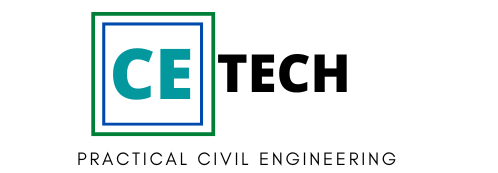In the construction world, a success rate of about 5:1 is common. This means out of every five bids, one is usually accepted. This shows how vital it is to get good at estimating bid prices to win profitable projects. This guide will cover the basics of estimating project costs, like the scope of work and how to bid with subcontractors and suppliers.
Contractors use data, site visits, and material takeoffs to make accurate bids. They break down costs, add markups, and plan for contingencies. We’ll also talk about the bidding process, submitting bids, and how technology helps in estimating costs.
Key Takeaways
- Successful project bidding requires a comprehensive approach to bid price estimation
- Accuracy in estimating project costs is crucial for the success of construction projects
- Contractors rely on accurate estimates to prepare competitive and profitable bids
- Reviewing bid documents, construction specifications, and contract documents is a standard process for construction estimators
- Dividing projects into work packages is essential for ensuring all work is accounted for and not assigned twice
Introduction to Construction Cost Estimating
Construction cost estimating is key to figuring out all costs for a project. It covers direct costs like materials and labor, and indirect costs like equipment and admin fees. Estimators do this early on to help everyone involved make a profit. They need to know a lot about materials, specs, and pricing trends.
What is Construction Cost Estimating?
It’s about breaking down all expected costs for a project. Estimators look at the project’s scope, materials, labor, and more to make a detailed budget. They aim to set a price that’s fair for the contractor and still makes a profit.
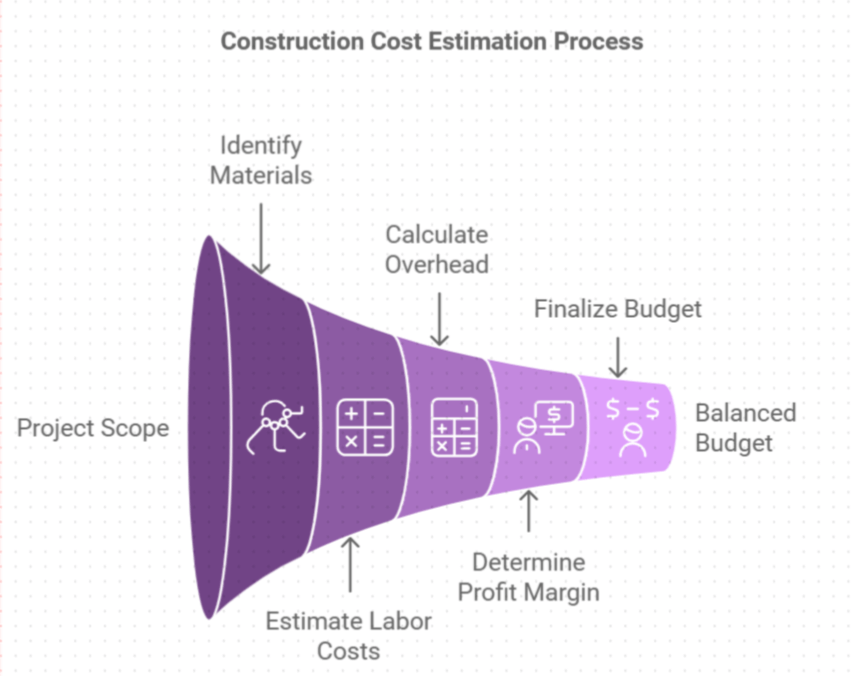
Importance of Accurate Cost Estimates
Getting the cost right is vital for any project. Owners use these estimates to see if they can afford the project. Contractors use them to make bids that are both competitive and profitable.
Estimators must account for every cost, including materials, labor, and overhead. This way, they can include a profit margin and a contingency plan in their estimates.
“Accurate cost estimating is the foundation of successful construction project management. It ensures owners can budget effectively and contractors can bid profitably.”
Key Components of a Project Cost Estimate
Cost estimation is not simply list of costs, however it also outlines the assumptions under each cost. The assumptions are included in a report called basis of estimate which includes the cost inclusions and exclusion as information for the stakeholders.
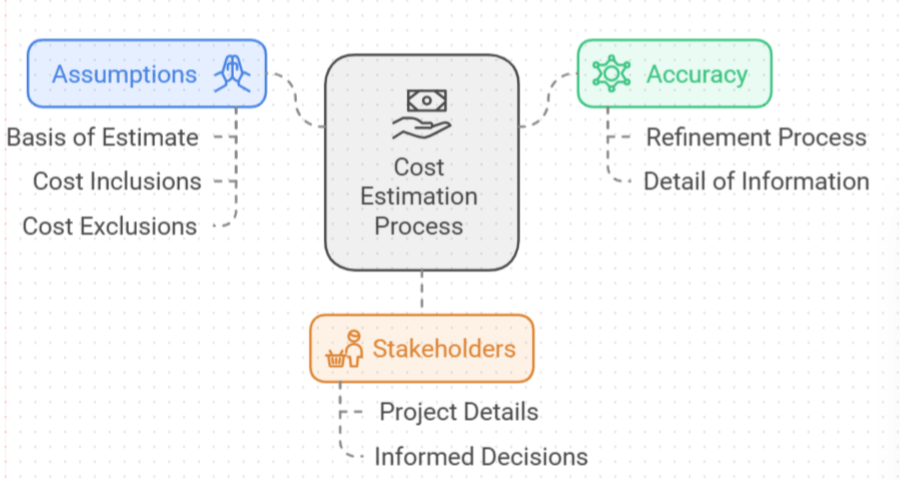
The process of cost estimation is not exact but an ongoing process that is refined according to the detail of information about the project. There fore the accuracy of cost of estimation is dependent on the detail of information about the project.
Creating a precise construction project cost estimate is a detailed task. It involves several key elements that estimators must carefully examine. The first and most critical element is the construction project scope of work. This defines what will be included in the project, setting the stage for the rest of the estimate. The general conditions are also vital, covering items and resources needed for project completion that won’t be part of the final product.
Self Estimate and Bill of Quantities
Creating a detailed self-estimate of the project’s bill of quantities is a crucial but time-consuming task. Estimators must analyze project drawings and specifications to understand the work needed. They must figure out the quantity and type of materials, identify special equipment or services, and calculate labor costs.
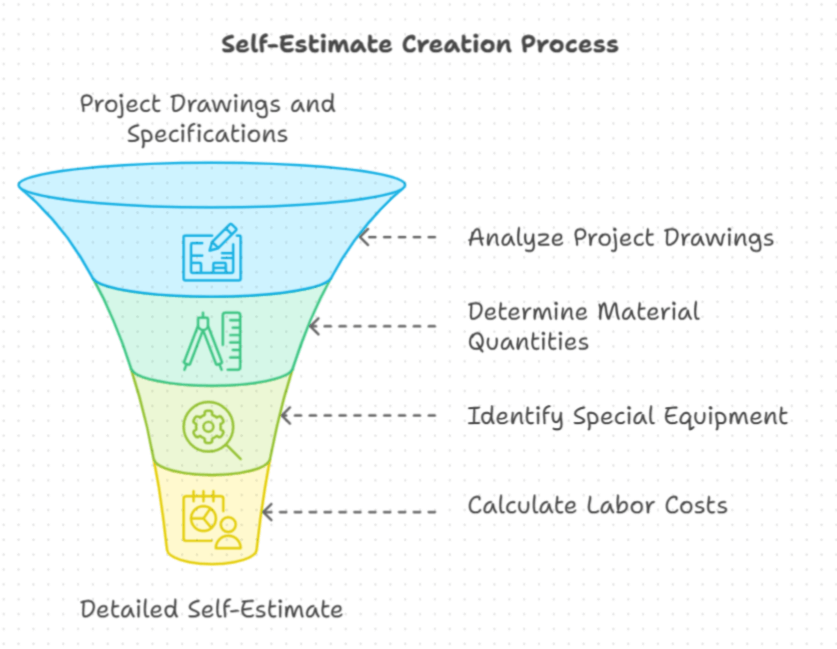
Bidding with Subcontractors and Suppliers
To get competitive quotes from subcontractors and suppliers, estimators need to know the market well. They must be able to produce quotes in different formats, analyze bids, compare proposals, and manage bid documents in one place. Effective management of construction subcontractor and supplier bids is key to creating a competitive overall project bid.
Type of cost estimation techniques
Project estimation techniques encompass various methodologies to predict project costs, timelines, and resources, ranging from data-driven approaches like analogous and parametric estimating to experience-based methods such as expert judgment and the Delphi technique.
The accuracy varies by method, with bottom-up estimating providing detailed component-level precision, while three-point estimating accounts for uncertainty by considering multiple scenarios, and resource costing focuses on specific expense calculations.
The selection of an estimation technique depends on factors like project similarity to past work, data availability, and complexity, with each method offering unique advantages in different contexts, from empirical costing’s effectiveness for similar projects to reserve analysis’s focus on contingency planning.
| Estimating Technique | Description | Accuracy |
| Analogous Estimating | Uses historical data from similar projects to estimate costs | Accurate for similar projects with percentage adjustments |
| Bottom-up Estimating | Detailed estimation of individual cost components | Higher accuracy with complete work breakdown structure |
| Parametric Estimating | Statistical modeling based on project factors | Highly accurate for uniform, repeatable tasks but may not work well for creative projects |
| Cost of Quality | Measures financial cost of ensuring products meet specifications | Includes preventing, identifying, and addressing defects |
| Delphi Technique | Expert consensus-based estimation to resolve discrepancies | Helps create reliable estimates through expert input5 |
| Empirical Costing | Uses previous project experiences to estimate costs | Provides accurate estimates for similar and frequent projects |
| Expert Judgment | Estimates based on expert knowledge and experience | Useful for order of magnitude and intermediate estimates, presented as a range due to project complexity |
| Reserve Analysis | Determines contingency reserves for known risks | Suggests techniques like padding to increase budgeted costs for activities |
| Resource Costing | Calculates project resource costs by multiplying hourly rate by projected hours | Provides detailed cost estimates for labor, equipment, and materials |
| Three-Point Estimating | Uses optimistic, pessimistic, and most likely estimates to calculate expected values | Provides more nuanced cost estimates to account for uncertainty |
Analyzing Project Data and Documentation
Before starting construction, estimators must carefully review the bid package. This package includes agreements, bond forms, and construction specifications. They need to know every detail of the project to make an accurate cost estimate.
Reviewing Bid Documents and Drawings
Estimators must analyze construction project drawings and understand construction specifications. This helps them fully grasp the project’s needs. A detailed review of the bid documents is key to avoiding gaps and overlaps in construction scope.
Dividing Project into Work Packages
After reviewing the documents, estimators subdivide the project into work packages. They assign these packages to specialty contractors. This requires careful attention to detail to ensure no work is missed7.
Clearly defining the scope of each work package is crucial. It helps avoid gaps or overlaps in the construction scope.
| Key Factors Influencing Cost Estimation | ||
| Project ComplexityTechnological RequirementsProject InformationProject Team RequirementsContract RequirementProject DurationMarket Requirements |
By reviewing construction bid documents and analyzing project drawings, estimators can divide the project into well-defined work packages. This ensures all project aspects are covered and assigned correctly. Such attention is vital to avoiding gaps and overlaps in construction scope, preventing costly delays and disputes.
“Competitive bidding was shown to lead to abnormally low bids and poor project quality in the construction industry due to opportunistic behavior.”
To reduce risks, estimators must understand construction specifications and define construction project work packages carefully. This ensures the project is bid and executed well.
Site Visit and Evaluation
Doing a thorough construction site visit is key in the bidding process. It helps estimators grasp the site conditions and their costs impact. They look closely at the site, taking notes and photos. They check for things like poor drainage, tough soil, and hard-to-reach spots that could raise costs.
Estimators use this visit to spot potential problems. They add needed steps to their bid to make sure the project goes well and is affordable. For remodeling jobs, this step is even more crucial. Estimators talk a lot with clients, make a clear plan, and show off their skills to offer a good deal.
| Key Factors Evaluated During Site Visit | Impact on Project Costs |
| Soil Conditions | Potential for extra foundation work or special digging |
| Drainage Issues | Need for better stormwater systems |
| Limited Site Access | More trouble with getting materials and handling them |
| Utility Locations | Possible extra costs for moving or fixing utilities |

By carefully evaluating the construction site conditions, estimators can guess and plan for the impact of site factors on project costs. This way, they can give a more precise and competitive bid. This careful work during the site visit phase is crucial for the bidding success.
“Conducting a detailed site visit is essential for understanding the unique challenges and requirements of a construction project. This knowledge allows us to provide our clients with more accurate and comprehensive bids.”
Material Takeoff and Quantity Calculations
The construction material takeoff process is key to project cost estimating. It needs special skills for managing data. If done wrong, it can lead to wrong cost guesses, affecting the whole project. It’s about figuring out what materials, resources, and labor are needed for a project.
New tech like Building Information Modeling (BIM) and Computer-Aided Design (CAD) has made estimating better. BIM gives a 3D view of designs, helping teams work together better. CAD lets teams design digitally first, making designs better and saving time.
There are old-school manual ways and new digital methods for quantity takeoffs. Digital methods are better for big projects because they’re faster and more detailed. Good data management is key for accurate takeoffs, helping make realistic contracts.
Many professionals work together in construction to get takeoffs right. Architects, engineers, and others are crucial for accurate estimates. Sometimes, experts are brought in to make sure estimates are precise.
To get a takeoff right, you need to put the right info into blueprints or software. This is important for a correct cost estimate. Estimates must be right to avoid losing money, as wrong guesses can cause delays or waste.
Without a good takeoff, giving a client a fair bid is hard. Estimators are key in making sure costs are right. The process includes checking project details, counting items, measuring, and figuring out costs
.
A good takeoff looks at materials, how much, labor, and equipment needed. Doing it well helps contractors get jobs, keep profits, and keep clients happy.
Quantity takeoffs (QTOs) are used in planning before construction starts. They break down projects to estimate costs well. It’s not just about counting materials, but also measuring work and materials needed.
Good quantity takeoffs are key for cost estimates and budgets. They help avoid going over budget in projects. Digital takeoffs are better than manual ones because they’re faster, more accurate, and reduce mistakes.
Digital takeoffs also let teams reuse data, work together better, and make sure everyone has access to project info.
Bid Price Estimation Technique: A Comprehensive Approach to Project Bidding
You need a detailed plan to get an accurate bid price for a construction project. This plan includes reviewing bid documents, visiting the site, and doing a detailed material takeoff and cost breakdown. It makes sure the final bid price covers all costs, including materials, labor, and profit.
Bidding price estimation and cost estimation are separate processes of estimating costs or projects with different objectives and processes. Cost estimation involves the internal calculation of actual project costs and focuses on determining the true cost of completing the work. It is used for project planning and financial feasibility analysis
Bidding Price Estimation is aimed at external pricing strategy for winning and profiting from projects Bid estimate Includes cost estimation plus strategic factors. The strategic factors such as market conditions, competition analysis, company workload, and capacity, geographic considerations, and client relationship value. It is applied to create competitive proposals and secure contracts that ensure acceptable profitability and rate of return.
Types of Bid price estimation techniques
The traditional methods that are often used in bid estimation are:-
- Unit Price Bidding,
– Contractors provide prices for individual work items
– Total bid is sum of (unit prices × estimated quantities)
– Best for projects with clearly defined scope
2 Lump Sum Bidding
– Single fixed price for entire project
– Contractor assumes quantity risk
– Suitable for well-defined projects with minimal unknowns
3.Cost Plus Bidding
– Contractor reimbursed for actual costs plus a fee
– Fee can be fixed or percentage-based
– Used when scope is uncertain or rapid start is needed
There are new methods that are also being implemented such as A+B bidding or cost plus time bidding and delphi bidding.
The A+B bidding method is popular for its two parts: the traditional bid for items (A) and the bid for project duration (B). The final bid is calculated by adding (A) and (B x Road User Cost / Day). This method is great for projects that cause a lot of delays, helping to reduce these impacts.
Many states in the USA now use the A+B Method after a successful test period. It has rules to discourage delays and reward early finish. Laws like 23 USC 112 and 23 USC 502 support this method.
Estimating project costs is key to managing them. Without good estimates, managing funds is hard, leading to cost overruns. Accurate estimates help in planning and making smart decisions
Good cost estimates build trust and show smart financial planning. They are vital for planning projects or products. There are many types of costs to estimate, like direct and indirect costs.
The U.S. Department of Energy has 8 rules for reliable cost estimates. Estimates are ranked from Class 5 to Class 1 based on accuracy and project phase. Class 5 estimates are rough, while Class 1 is very accurate.
The Delphi Method is a way to get cost estimates by asking experts. It’s a good method for getting accurate cost estimates.
| Technique | Description |
| A+B Bidding Method | Consists of two components: the traditional bid for contract items (component A) and the bid for the total number of calendar days required to complete the project (component B). The bid for award consideration is calculated using the formula: (A) + (B x Road User Cost / Day). |
| Delphi Method | An interactive forecasting technique that utilizes a group of experts to reach a consensus on cost estimates. |
By carefully looking at project data and documents, estimators can make a detailed bid price. This ensures a complete and accurate bid price estimation.
“Developing an accurate bid price for a construction project is crucial for the success of the project, as it directly impacts the profitability and financial viability of the undertaking.” – Construction Industry Expert
Direct and Indirect Cost Breakdown
Getting construction costs right is key for winning bids and making projects profitable. Estimators must look at both direct and indirect costs.
Labor Costs
Labor costs are a big part of direct costs. They include wages, benefits, taxes, and how well workers do their jobs. It’s vital to estimate these costs well to make a bid that’s fair and meets the project’s needs.
Material Costs
Materials are another big direct cost. This includes the cost of materials and any extra fees for getting them there. Estimators need to know the latest prices and exactly what materials are needed.
Equipment Costs
Equipment costs, like for heavy machinery, tools, and special vehicles, are also direct costs. Estimators must think about rental or buying costs, and the costs of running and keeping the equipment in good shape.
Overhead and Administrative Costs
Indirect costs, or overhead, are needed to finish the project. They include things like office space, utilities, and software. Getting these costs right is important for making sure the bid is profitable and can be kept.
By looking closely at both direct and indirect costs, estimators can make bids that are both accurate and competitive. This helps their company succeed in the tough construction market.
“Accurate cost estimation is the foundation of a successful construction project. Overlooking any direct or indirect expenses can lead to significant financial risks and jeopardize the project’s profitability.” – John Doe, Chief Estimator at XYZ Construction
Markup, Profit Margin, and Contingencies
When estimating construction costs, estimators must figure out the markup, profit margin, and contingency fund. The markup covers the contractor’s overhead and profit. The contingency fund is for unexpected costs or risks during the project.
The average general contractor markup on labor is 25% and higher. On materials, it can reach up to 50%. Experts say contractors should mark up labor by about 25% and materials by 30% to 50%. Builders usually make a pre-tax net profit of 1.4% to 2.4%, while subcontractors make slightly more, between 2.2% to 3.5%.
To get a desired profit margin, the markup on costs must be calculated carefully. For example, a 15% profit needs a 17.65% markup, a 25% profit requires a 33.33% markup, and a 35% profit needs a 53.85% markup. Remember, markup is added to the cost price, and margin is subtracted from the revenue.
Contingency planning is key in construction project bidding. Builders should include a contingency amount in their estimates for unforeseen factors during construction. This provides a buffer for potential cost overruns or changes in project scope. By using customizable markup rates and financial settings, construction professionals can make the estimation process more efficient and accurate.
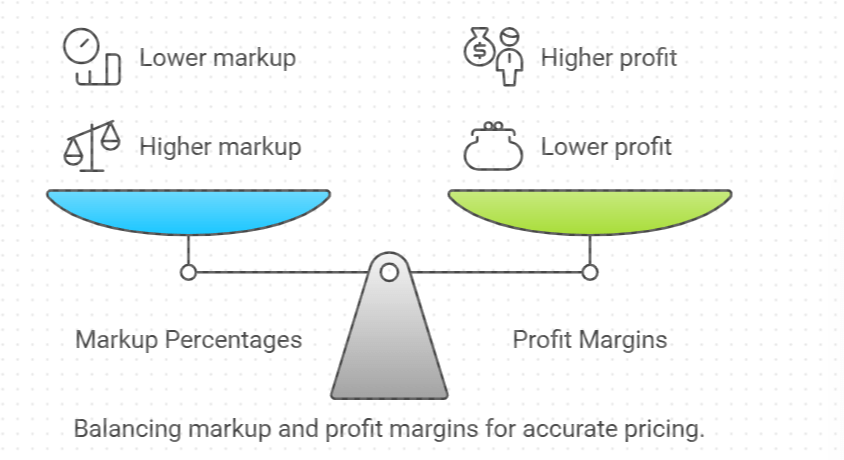
- Markup is the percentage added to the cost price of goods to cover overhead and profit.
- Margin (or Profit Margin) is the percentage of the selling price that is profit.
| Markup | Margin |
| 15% | 13.0% |
| 20% | 16.7% |
| 25% | 20.0% |
| 30% | 23.0% |
| 35% | 25.9% |
| 40% | 28.6% |
| 50% | 33.0% |
| 100% | 50.0% |
“Constraining a pricing strategy based on a flat markup percentage often does not consider the actual costs of materials, leading to inaccurate pricing and potential losses for contractors.”
Bid Submission and Evaluation Process
The construction bid submission process is key to getting a project. Contractors must prepare and submit their bids, which may include a bid bond, to the project owner or manager. The owner then reviews these bids and picks the best contractor based on several factors.
When reviewing bids, the owner looks at the price, the contractor’s experience, safety record, and how they plan to deliver the project. The bid leveling process makes sure all bids are compared fairly, ensuring a fair selection.
The way bids are handled in construction can affect the process. Open tendering lets anyone bid, making the process competitive and diverse. Selective tendering narrows down the bidding pool to a few trusted companies. Negotiated tendering involves just one vendor, usually a well-known company.
The bidding process can start with an Invitation for Bid (IFB), Request for Quote (RFQ), or Request for Proposal (RFP). It can take weeks or months to review all proposals and choose vendors. Once chosen, the project work begins, and the client gets what was planned.
Project managers play a big role in bidding and tendering. They can be on the side of the hiring organization or the service providers. Knowing the bid and evaluation process helps contractors win more projects and succeed.
Role of Technology in Cost Estimating
Construction cost estimating and bidding software are key in making the cost estimating process smoother. They offer accurate and current construction cost information. These tools save time, reduce errors, and help contractors make better decisions. They also keep contractors competitive with features like bid management and cost analysis.
The use of artificial intelligence (AI) and machine learning (ML) in these software tools is changing the game. These technologies quickly and accurately analyze huge amounts of data. This leads to more reliable cost estimates. AI and ML can predict costs based on project size, complexity, and location with great accuracy.
Moreover, AI and ML in these tools can import data from various sources in real-time. This gives a full view of project costs. These technologies also help predict risks and suggest ways to mitigate them. This ensures more accurate cost estimates.
Leading software like ProjStream’s BOEMax and WorkBench are already using AI and ML. They automate tasks like data importation and predictive cost modeling. This makes cost estimates thorough and reliable. These tools also offer user-friendly interfaces and advanced analytics, giving contractors a big advantage.
Using old systems without cloud architecture and AI and ML can hold contractors back. Embracing technology in cost estimating can make bids more accurate, efficient, and credible. This boosts a contractor’s edge and profit.
“The integration of AI and ML in construction cost estimating software has revolutionized the way contractors approach project bidding. These advanced technologies have transformed the industry, enabling more accurate, efficient, and data-driven decision-making, ultimately driving a competitive advantage for those who embrace them.”
| Feature | Benefit |
| Access to extensive cost database | Provides up-to-date information on material and labor costs |
| Automated takeoff measurements | Saves time and reduces errors compared to manual calculations |
| Integration with project management software | Enables seamless scheduling and resource allocation |
| Reporting and data visualization | Offers customizable reports with detailed cost breakdowns and visual representations for easier analysis |
By using construction cost estimating software, contractors can make their bidding process better. They can also improve the accuracy of their cost estimates. This gives them an edge in the industry. These tools offer advanced features and data insights, making them crucial for modern construction businesses.
Conclusion
Creating an accurate bid price for a construction project is complex. It involves a detailed approach. Key points include reviewing bid documents and drawings. Also, conducting site visits and evaluating them, and doing detailed material takeoff and quantity calculations.
Getting accurate construction cost estimates is key for project success. Managing costs well is important for businesses during bidding. This helps companies increase their profit margins and win more bids. As projects grow bigger and more complex, being able to estimate costs well will be crucial for staying ahead.
Looking to the future, construction bidding will rely more on technology. This includes bid tabulation software and cost estimation tools. By using these tools, construction companies can make their bidding processes better. They can also access important market data and make smarter decisions. This will help them stay competitive and profitable.
FAQ
What is the scope of work in a construction cost estimate?
The scope of work outlines what will be included in the project. It’s the first step in creating a cost estimate. It sets the stage for the rest of the estimate.
Why is performing a detailed self-estimate of the project’s bill of quantities crucial?
Doing a detailed self-estimate of the bill of quantities is key. It’s a time-consuming task but essential for estimators. They need to analyze project drawings and specifications to understand the work fully.
How do construction estimators manage subcontractor and supplier bids?
Estimators need to know the market well to get good quotes from subcontractors and suppliers. They must be able to produce quotes in different ways. They also need to compare proposals and manage bid documents.
Why is it crucial for estimators to thoroughly review the bid package?
Estimators must carefully review the bid package. This includes agreements, bond forms, and construction specifications. Knowing these documents well is key to making an accurate cost estimate.
How do site visits help construction estimators?
Site visits are important for estimators. They help understand the site conditions and their impact on costs. Estimators take notes, photos, and talk to contractors to assess the project’s feasibility and cost.
What is the purpose of a material takeoff in construction cost estimating?
Estimators do a material takeoff by counting every item needed for the project. They list items by quantity or area. Even with a BOQ, contractors often do their own takeoff to check quantities and find discrepancies.
What are the key components of a direct cost breakdown in a construction bid?
Direct costs include labor, materials, and equipment. Estimators must calculate labor costs, check material prices, and consider equipment costs. This ensures accurate costs in the bid.
How do construction estimators account for indirect costs in the bid price?
Indirect costs like equipment depreciation and site management are important. Estimators must consider these costs to ensure the bid price is profitable. Accurate accounting for indirect costs is crucial.
What factors do construction project owners consider during the bid evaluation process?
Owners look at price, experience, safety record, and project delivery method during bid evaluation. The bid leveling process helps standardize and compare bids.
How can construction cost estimating software help with the bidding process?
Cost estimating and bidding software streamlines the process. It provides accurate and up-to-date cost information. These tools save time, reduce errors, and help contractors make informed decisions.
Source Links
- The Construction Bidding Process Explained | Procore – https://www.procore.com/library/construction-bidding-process
- Construction Cost Estimating: A Step-By-Step Guide | Procore – https://www.procore.com/library/construction-estimating
- PDF – https://www.lausd.org/cms/lib/CA01000043/Centricity/domain/184/audit files/Ultimate Guide to Project Cost Estimating.pdf
- Project Management for Construction: Cost Estimation – https://www.cmu.edu/cee/projects/PMbook/05_Cost_Estimation.html
- Ultimate Guide to Project Cost Estimating | Smartsheet – https://www.smartsheet.com/ultimate-guide-project-cost-estimating
- Project Cost Estimation: How to Estimate Project Cost – https://www.projectmanager.com/blog/cost-estimation-for-projects
- A Statistical Approach to Analyzing Engineering Estimates and Bids – https://www.mdpi.com/2571-905X/4/1/5
- The full guide to construction bidding: Definition, tips & more – https://buildertrend.com/blog/construction-bidding/
